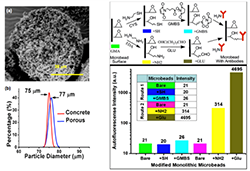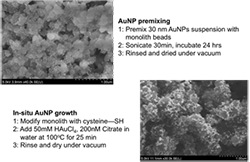![]() Nanotechnologies for Trace Explosives Detection
Nanotechnologies for Trace Explosives Detection
PI: Prof. Don DeVoe
We have continued our exploration of nanotechnology-enabled platforms for trace gas-phase explosive detection, with a primary focus on developing functionalized nanoporous materials as novel surfaces for ultrasensitive analysis of adsorbed explosives by surface-enhanced Raman spectroscopy (SERS). A variety of nanostructured porous surfaces have been demonstrated with high specific surface areas for enhancing analyte adsorption/concentration and increasing SERS signals through optical interactions with the structured substrates. While our previous work was focused on nanofilament silicon dioxide and microporous anodic alumina, our recent efforts over the past year have been primarily directed toward the attachment of gold nanoparticles (AuNPs) to porous polymer and silica monoliths as SERS-active substrates for performing remote optical gas-phase detection of explosive molecules. In particular, we have developed a microfluidic-enabled method to produce large numbers of monodisperse porous microbeads fabricated from glycidyl methacrylate polymer (Fig. 1).

Fig. 1 (a) cleaved polymer microbead showing porous interior matrix. (b) Porous and non-porous bead sizes revealing nearly monodisperse distributions. (c) Microbead functionalization route for antibody attachment, and evaluation of autofluorescence demonstrating moderate optical background for SERS detection.
The microbeads serve as discrete sensing elements that can be functionalized with (bio)molecules for selective capture and concentration of target molecules, and AuNP functionalization has been optimized for the porous polymer sensor particles.
Two routes for AuNP functionalization have been optimized based on either pre-mixing of nanoparticles with the prepolymer solution used to prepare the porous microbeads, or in-situ growth of AuNPs after microbead synthesis (Fig. 2). Both routes were found to yield good nanoparticle coverage, with the first method providing more controllable distributions of AuNP clusters suitable for SERS sensing.

Fig. 2. Comparison of AuNP premixing and in-situ growth routes for SERS-active nanoparticle integration within monolith microbeads.
While experimental results for TNT vapor detection using AuNP functionalization microbeads have been promising, the limit of detection was found to be constrained by the background fluorescence of the polymer matrix (Fig. 1c). To overcome this limitation we have begun work on a process to prepare porous microbeads from a silica matrix, using a similar microfluidic-enabled synthesis route but using high-temperature batch processing of the microbeads collected from the outlet of the microfluidic chip. Continuous porous silica structures have been successfully achieved, and microbead processing is currently in progress.

